|
Related FAQs: Fishes of
Hawai'i, Articles on: The Best
Butterflyfishes of Hawai'i, Triggerfishes of
Hawai'i,
Related Articles: Introduction to Fishwatcher's Guide
Series Pieces/Sections, Scott's Trip to
Maui/Hawai'i, Holualoa property,
Hawaiian Marine Biotopes,
Part 4
To: Part 1, Part 2, Part 3, Part 5, Part 6, Part 7,
|
|
|
Bob Fenner
|
|
Damselfishes, Family
Pomacentridae:
For economic reasons (similar and same species are much cheaper
collected elsewhere), and practical (theyre mostly in the upper water
column where collectors nets arent) damsels are by and large ignored in
Hawaii. Of the seventeen known species there are a few that make it
into the trade sporadically.
|
Abudefduf abdominalis (Quoy &
Gaimard 1825), the Green Damselfish,
or Maomao if you're in Hawai'i. Central Pacific, Hawaii
to Polynesia.
To eight inches in length in the wild. Here's one in
Hawai'i.
|
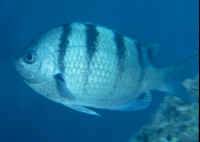
|
|
Abudefduf vaigiensis (Quoy &
Gaimard 1825), the Indo-Pacific Sergeant Major. Eastern coast of
Africa and Red Sea (where this picture was taken), out to the
Line and Tuamotu Islands. To six inches long. Fourth black body
bar originates after hard dorsal fin.
|
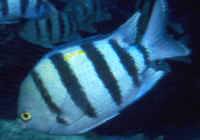
|
|
Chromis vanderbilti (Fowler 1941),
Vanderbilt's Chromis. A small beauty (to two inches) of the
Central and West Pacific. This one in the Cook Islands. A rare
import best kept in a small school in a peaceful setting.
|
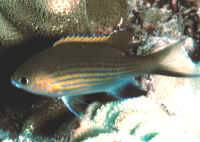
|
|
Dascyllus albisella Gill 1862, the
Hawaiian Dascyllus. Central Pacific: Hawaiian and Johnston
Islands. To five inches. A poor shipper, and as nasty a biter as
the similar Three-Spot, Domino, Dascyllus trimaculatus.
Hawai'i pix.
|
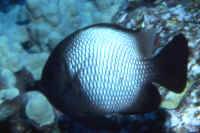
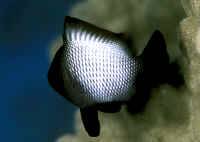
|
Shallow Rocky Reef Wrasses:
|
Halichoeres ornatissimus (Garrett 1863) is (one of) the
three " Christmas Wrasses", aka the Ornate Wrasse to
science. This can be a very hardy fish should you secure an
initially healthy specimen. Unfortunately, way to many are doomed
from the trauma of rough handling through the collection process.
To six inches. Aquarium photo. Indo-Pacific to Hawai'i, where
it is best imported from.
|
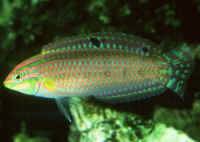
|
|
The endemic, Labroides phthirophagus Randall 1958,
Hawaiian Cleaner Wrasse. To nearly five inches in length. A
beauty, but fares no better than other members of the genus and
should be left in the islands to do its cleaning, and live.
Aquarium and Hawai'i pix.
|
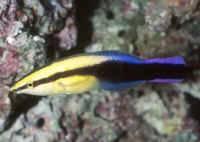
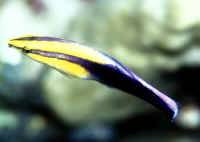
|
Wrasses of the Genus
Pseudocheilinus:
Due to their cryptic nature, most folks, including
sports divers are unaware of the common presence of lined wrasses in
Hawai.
|
Pseudocheilinus evanidus Jordan & Evermann 1903,
the Pin-Striped or Striated Wrasse. I like this fishs other
common names, the Disappearing or Vanishing Wrasse for its
bashfulness. To a grand size of three inches. Indo-Pacific,
including Red Sea and Hawai'i. This one in the Red Sea.
|
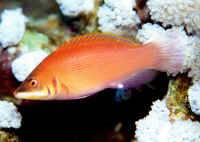
|
|
Pseudocheilinus octotaenia Jenkins 1901, the
Eight-Lined Wrasse comes in two color morphs, one more orange,
the other more pinkish in body hue. Both can become agonistic
toward other fishes. Under-crowding, over-decorating and keen
observation are called for here, as always. Indo-Pacific,
including Hawai'i.. To five and a half inches in length. Both
color morphs shown in captivity.
|
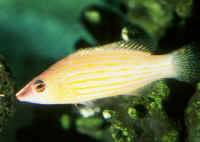
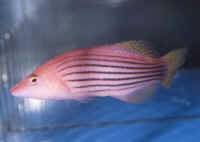
|
|
Pseudocheilinus tetrataenia Schultz
1960, take a guess, yes; the Fourline Wrasse (2), is mainly
collected out of Hawaii. It is also a three-incher that like all
members of the genus is best kept one to a tank. Western central
Pacific. To three inches total length.
|
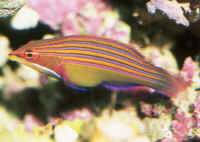
|
A Bunk Blenny Import:
|
Exallias brevis (Kner 1868), Leopard
Blenny. Indo-Pacific; Red Sea to Hawaiian, Marquesas Islands. To
almost six inches in length in the wild. Obligate feeders on live
coral polyps. Definitely NOT reef safe. Still offered on pet-fish
markets on occasion. A male in Oahu, Hawai'i female at a
marine wholesalers in L.A. starving...
|
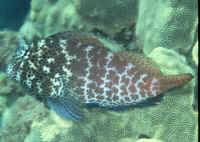
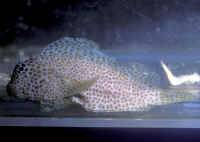
|
Shallower Water
Surgeonfishes:
|
Acanthurus. achilles Shaw 1803,
Achilles tang. Widely distributed from Hawaii westward through
Micronesia and Melanesia, an area called Oceania. Though the best
specimens do hail from U.S.s 50th state success with this species
can only be had by securing a healthy specimen, providing a large
well-established living space, with high, consistent specific
gravity and oxygen concentration. Shown, one in the Cooks.
|
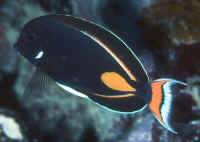
|
|
Acanthurus dussumieri Valenciennes
1835, the Eyestripe or Dussumier's Surgeonfish. This is a
highly variably colored fish. Some are drab gray, whereas some
I've seen from Hawaii sported brilliant yellow around their
body margin with beautiful royal purple highlights. This surgeon
is more like the genus Ctenochaetus in its feeding habits,
sifting sand and detritus in addition to algae scraping. A
specimen off Maui. To eighteen inches long in the wild.
|
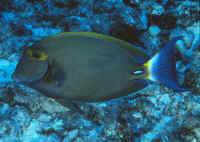
|
|
Acanthurus nigricans (Linnaeus 1758)
Goldrim to science, Powder Brown Surgeonfish to aquarists.
Formerly mis-identified as A. glaucopareius. Pan Pacific. To
about eight inches maximum length. See article on this and the
very similar, but more pet-fish-appropriate A. japonicus.
Specimens below from Australia, the Cooks (Roratonga) and Baja,
Mexico.
|
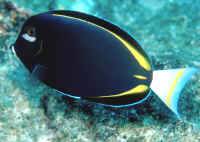
|
|
Acanthurus olivaceus Forster &
Schneider 1801, the Orange Spot/Shoulder Tang. A hardy fish out
of Hawaii and elsewhere, but unfortunately, a behavioral terror
in the ranks of A. lineatus. This is an active fish that
grows to more than a foot in length. Place only with MEAN
tankmates. A juvenile and adult pictured, Fiji and Hawai'i
respectively.
|
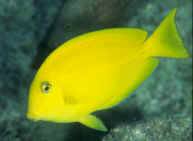 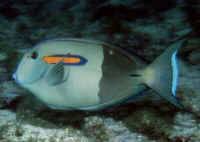 < ![endif]> < ![endif]>
|
|
Acanthurus nigrofuscus (Forsskal 1775), the blackish
Brown or Spot-Cheeked Surgeonfish. Manageable size (to eight
inches), and moderate behavior toward other fishes qualify the
Brown Tang as a desirable aquarium species especially as an algae
controller. Unfortunately it is a rather plain fish. Red Sea
image.
|
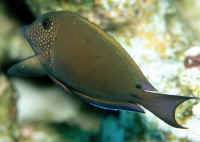
|
|
Acanthurus triostegus (Linnaeus 1758), (manini) Convict
Tang or Manini (Hawaiian). One of the best Acanthurus for use in
reef tanks for its size, easy going temperament and habit of
consuming fine, filamentous algae. Reserved for native Hawaiian
use in Hawai'i, but available from elsewhere. Juvenile in
Hawai'i .
|
|
Ctenochaetus strigosus Bennett 1828,
the Yellow-eyed or Kole Tang; since this and the
Chevron Tangs range encompass the principal islands of Hawaii
they are the principal species
utilized in the West (though the Kole is found from all the way
over in the Indian Ocean).
The Kole ("coal-ay") is more shallow water, surface to
sixty feet or so, and the chevron
is generally collected in fifty feet plus. Aquarium, Cook
Islands and Bunaken, Sulawesi,
Indonesia images below to show diversity in color, markings....
almost always a discernible
yellow eye surround... body and tail color differing.
|
|
|
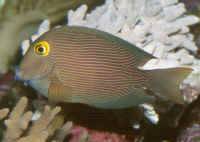
|
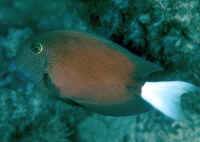
|
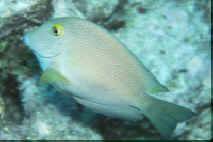
|
|
|
Naso lituratus, the Naso Tang to most aquarists;
it is also known as the tricolor or lipstick tang. There are some
who claim that "blonde" and "streamer"
versions are different species; they're all Naso
lituratus. To eighteen inches in the wild. Below, a Naso in
an aquarium, he business end of a Naso in Hawai'i, and a
beautiful "streamer" (male) there getting cleaned by a
Cleaner Wrasse. Sometimes found right at the surface,
feeding on intertidal algae, but also deepwater.
|
|
|
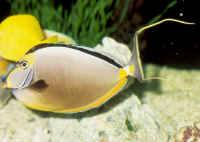
|
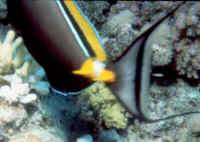
|
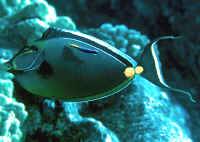
|
|
Naso unicornis (Forsskal 1775), the Bluespine, Large or
Bignose Unicornfish, is a deep-bodied species that develops a
prominent rostral horn starting at about five inches length. The
body is light olive to gray with yellowish highlights on the
abdomen; to more than two feet. Adult and juvenile shown.
|
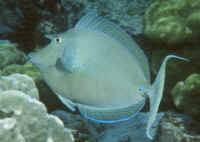 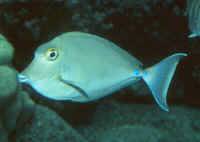
|
|
|
Zebrasoma flavescens (Bennett 1828), (lau'ipala)
the Yellow Sailfin Tang. This is a "standard" in the
marine aquarium hobby if there ever was one. Only certain
damselfish species grace the tanks of aquarists more than Z.
flavescens. To plate size, eight inches, in the wild. Below:
an exemplary specimen in an aquarium, a batch at a wholesalers in
Los Angeles, and a roving school in Hawai'i off of Poako on
the Big Island.
|
|
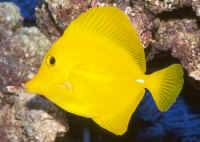
|
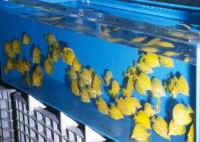
|
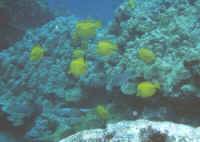
|
|
|
Zebrasoma veliferum (Bloch 1795), the
Pacific Sailfin Tang. Collected out of the Philippines and
Indonesia, though better out of Hawaii, Ceylon and other places
in the eastern Pacific. Some call this THE Sailfin tang for
it's gorgeous flowing dorsal and anal finnage; these
especially over-sized in appearance when young. Here are two and
four inch juveniles in Fiji and a larger (10") individual in
Hawai'i. As mentioned above D. desjardinii is
considered a junior synonym of this species currently.
|
|
|
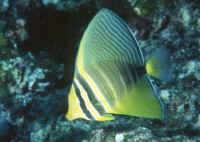
|
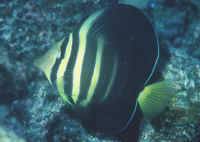
|
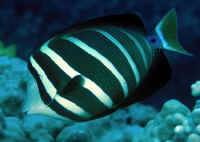
|
To: Part
1, Part 2, Part 3, Part
5, Part 6, Part 7,
|
|

